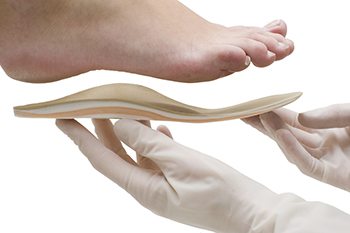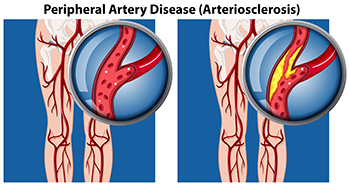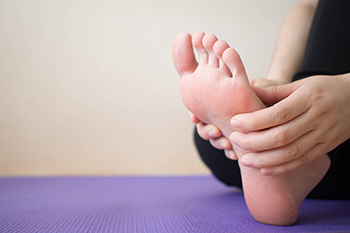Summer can be a time when the feet are particularly vulnerable to various medical problems. This is because the warm weather means that many people will wear shoes that do not adequately cushion and protect the feet or will go barefoot entirely. Fortunately, most summertime foot problems can be treated or prevented.
In the summertime, most people frequent warm, moist public areas, such as swimming pools, locker rooms, and showers, walking around barefoot. These places are breeding grounds for various fungi and viruses that can get into the feet, causing an infection. Tinea pedis, or athlete’s foot, is a fungal infection of the skin on the feet. It’s characterized by a red, scaly, itchy rash and skin peeling, usually found between the toes. Fungus can also infect the toenails, making them brittle, crumbly, thickened, and discolored. Human papillomavirus (HPV) is a common viral infection that can cause benign, fleshy growths called warts to grow on the soles of the feet. When going to public places, it’s suggested that you wear shoes to protect your feet from infectious agents and that you avoid sharing personal items like shoes and towels with others.
For many people, staple summer footwear includes flip-flops and open-back, open-toe sandals. Unfortunately, these shoes are usually flimsy and don’t protect the feet or provide any support or cushioning. Some also require you to scrunch up your toes while you walk to keep the shoes on your feet. This can lead to a variety of foot and ankle injuries, heel pain, arch pain, bunions, hammertoes, and dry, cracked heels. When shopping for summer shoes, look for shoes that fit properly and have adequate cushioning in the heel and arch area. They should stay on your feet while you walk without any effort and protect your feet from the elements. If you must wear flip-flops, limit wear to just a few hours every few days, or when going to specific places like the pool or beach.
For more information about common summer foot problems and how to treat and prevent them, please consult with a chiropodist.

The feet tend to be ignored during the winter months, and foot care often ceases. As the summer months approach, many people pay attention to skin and nail conditions on their feet. Pedicures become popular again, as the feet are soaked, scrubbed, and polished, often giving the feet a groomed appearance. People who choose to care for their toenails at home may achieve a similar result when the nails are filed straight across. It is important to make sure filing is performed on dry skin, in addition to ensuring all nail instruments are clean and hygienic. Applying a good moisturizer generally helps the skin to feel smooth, in addition to preventing unsightly conditions, such as cracked heels, from developing. When a foot care regime is routinely performed, the benefits can include having healthier and prettier feet. If you would like more information about successful foot care tips, it is suggested that you speak with a chiropodist who can provide you with the knowledge you are seeking.
Summer is the season for many foot and ankle issues. If you’re suffering from a foot or ankle problem, please consult with one of the chiropodists from The Footcare Centre. Our chiropodists can help you maintain the health of your lower limbs and your mobility.
Common Summer Foot Problems
Athlete’s foot
Toenail fungus
Plantar warts
Foot and ankle injuries
Bunions
Hammertoes
Heel pain
Cracked heels
Sunburns
Blisters
Prevention
Wear supportive shoes and avoid flip-flops
Maintain good foot hygiene
Exfoliate and moisturize the heels
Apply sunscreen to the feet and ankles
Wear shoes in public areas like swimming pools, locker rooms, and showers
If you have any questions, please feel free to contact our office located in . We offer the newest diagnostic and treatment technologies for all your foot care needs.
Orthotics are medical devices that are typically placed in your shoes. They are used to treat a variety of foot and ankle conditions. Depending on your needs, orthotics can correct gait abnormalities and biomechanical issues, ease foot and ankle pain, correct or prevent the progression of deformities, cushion and support the foot, evenly distribute weight, and help injuries heal more efficiently.
There are many different types of orthotics available on the market. Some can be bought over-the-counter at most major retailers. Others need to be prescribed by a foot and ankle specialist and are custom-made to fit the unique needs of your feet. Orthotics come in various forms, including full-length and half-length shoe inserts, heel cups or pads, splints, braces, and more. Depending on the type of orthotic, it can be made from rigid materials, like carbon fiber or plastic, or soft materials, like memory foam.
The type of orthotic that is right for you depends on the foot or ankle problems that you are facing, as well as the unique characteristics of your feet, such as their structure and biomechanics. If you are interested in exploring orthotics as a potential treatment option for your foot or ankle problems, it is suggested that you consult with a chiropodist. A chiropodist can examine your feet to determine your specific needs and find the right orthotics for you.

Orthotics can either be custom-made or over-the-counter inserts meant to be worn inside shoes serving a variety of functions. Orthotics can mitigate pain, help treat foot conditions or even help correct deformities. Many patients often ask who can wear orthotics and who might be able to benefit from them. The answer is that many people can potentially benefit from wearing orthotic devices. Some individuals can certainly benefit more than others by wearing orthotics. For example, if a patient has an average weight and height, they might benefit from wearing orthotic devices, especially for heel pain. By wearing orthotics, a patient can potentially decrease the amount of pain they are feeling in their feet. Contact a chiropodist today for more information.
Orthotics are devices that are typically inserted into shoes to treat a variety of foot and ankle problems. If you would like to learn more, please consult with one of the chiropodists from The Footcare Centre. Our chiropodists can help you maintain the health of your lower limbs and your mobility.
What Are Orthotics Used For?
Orthotics are used for the treatment of a variety of foot and ankle problems. These can include biomechanical issues, gait abnormalities, foot pain, injuries, arthritis, deformities, and other medical conditions that affect the lower limbs. Orthotics can be bought in a store or custom-made and prescribed by a chiropodist.
Types of Orthotics
Rigid - Made from carbon fiber or other hard material and designed to ease foot pain and strain
Soft - Made from flexible materials like foam and designed to cushion and support the foot
Full shoe inserts
Half shoe inserts
Heel cups
Heel pads
Night splints
Braces
And more
If you have any questions, please feel free to contact our office located in . We offer the newest diagnostic and treatment technologies for all your foot care needs.
Peripheral artery disease (PAD) is a condition that causes poor circulation in the lower limbs. This occurs due to a buildup of a fatty substance called plaque in the arteries that supply the lower limbs. The plaque buildup causes the arteries to narrow and harden, restricting blood flow.
In its initial stages, PAD may not cause any noticeable symptoms. As the condition progresses, the first sign of PAD is usually claudication, a pain or cramping in the lower legs that occurs during walking or exercise. Claudication is caused by reduced blood flow to the muscles in the lower legs. Other symptoms of PAD that may appear over time include pain, numbness, heaviness, or achiness in the leg muscles, weak or absent pulses in the legs and feet, slow-healing wounds on the legs or feet, skin discoloration, poor toenail growth, poor hair growth on the legs, and low leg temperature. These are all signs of decreased circulation in the legs.
PAD is a particularly dangerous condition because it can increase your risk of having a stroke or heart attack. Complications or a total loss of circulation can also increase your risk of limb amputation. A chiropodist can screen you for peripheral artery disease using quick, noninvasive vascular tests. The Ankle-Brachial Index, a test that measures the blood pressure in your arm and in your ankle and then compares the two numbers to see if you are at risk for PAD, and ultrasound imaging of the blood vessels in your legs, are frequently used as screening measures.
If you have symptoms of PAD, or if you have been diagnosed with PAD and would like to learn more about maintaining the health of your lower limbs, please consult with a chiropodist.

When the blood flow to the feet is slowed, it is typically the result of a buildup of fatty plaque in the arteries serving the lower extremities. This blockage is known as peripheral artery disease or PAD. Risk factors for peripheral artery disease include smoking, high blood pressure, high cholesterol, and aging. Telltale signs of PAD in the ankles and feet are sores or wounds that won’t heal, an absence of a pulse in the feet and toes, and cold or numb toes. One way to help prevent peripheral artery disease is to participate in physical exercise regularly. It is also imperative to stop smoking, because it not only increases the risk of PAD, it also makes any symptoms you may have worse. If you are predisposed to cholesterol or diabetes, they should also be monitored closely. If you need information on peripheral artery disease, it is a good idea to consult a chiropodist who can examine your feet and suggest appropriate treatment options.
Peripheral artery disease (PAD) is a serious condition that can increase your risk of having a stroke or heart attack. If you have symptoms of PAD, please consult with one of the chiropodists from The Footcare Centre. Our chiropodists will assess your condition and provide you with quality foot and ankle treatment.
What Is Peripheral Artery Disease?
Peripheral artery disease (PAD) is a condition in which the arteries that supply blood to the lower limbs narrow and harden due to a buildup of arterial plaque. PAD causes a reduction in blood flow to the legs and other extremities.
Symptoms
Often, people with PAD experience no symptoms, especially in the early stages. If PAD continues to worsen, the first sign of PAD may be claudication, pain and cramping in the legs while walking, caused by the reduction of blood supply to the muscles of the legs.
Other potential symptoms include:
Numbness or weakness in the legs
Coldness in the legs or feet
Slow-healing sores or wounds
Skin discoloration or hair loss on the legs
Slow growth of toenails
Diagnosis
Most often chiropodists utilize a test called an ankle-brachial index (ABI). An ABI test compares blood pressure in your arm to the blood pressure in your ankle to see if any abnormality occurs. Vascular tests look at the blood flow in the legs and are generally painless and non-invasive.
Treatment
Lifestyle changes, such as eating a healthy diet and exercising regularly can help limit further arterial plaque buildup. Taking your prescribed medications can reduce your risk of stroke and heart attack. In some cases, surgery may be required to improve blood flow.
If you have any questions, please feel free to contact our office located in . We offer the newest diagnostic and treatment technologies for all your foot care needs.
Foot pain is a common symptom of a large variety of injuries and medical conditions. A diagnosis can be narrowed down by describing the locations and type of pain that you are experiencing.
Pain in the heel is often caused by plantar fasciitis, an inflammation of the ligament that runs along the bottom of the foot and connects the heel to the toes. Plantar fasciitis usually causes stabbing heel pains and the pain is at its worst upon arising in the morning or when taking your first steps after a long period of rest. Heel pain can also be caused by heel spurs, bruises on the fat pad of the heel, or heel fractures.
Pain in the ball of the foot can be caused by Morton’s neuroma, in which the tissue of the nerves between the bases of the toes become thickened, causing tingling and numbness. Other causes of pain in the ball of the foot include metatarsalgia or sesamoiditis.
Pain in the arch of the foot can be caused by plantar fasciitis or having flat feet or fallen arches. Pain in the toes can be caused by many conditions, including gout, bunions, hammertoes, ingrown toenails, toe sprains or fractures, arthritis, and corns.
To find out what is causing your foot pain, it is recommended that you consult with a chiropodist, who can diagnose your condition and offer the appropriate treatments.

Many people have foot pain for various reasons. Often, resting the foot can reduce the pain and discomfort, however, it is beneficial to know the cause behind it. Wearing shoes that do not fit correctly is a common reason to experience foot pain, and can easily be remedied when the right size shoes are worn. Patients who are overweight may develop heel spurs and plantar fasciitis. These are uncomfortable conditions that may come from the excessive weight which is placed on the heel. There are certain medical conditions that may also lead to foot pain. These can consist of gout which is a form of arthritis, circulation or nerve issues, or flat feet. If you have foot pain for any reason, it is strongly urged that you are under the care of a chiropodist who can effectively determine the cause, and offer correct treatment options.
Foot pain can have many causes. To receive an accurate diagnosis and treatment for your foot pain, please consult with one of the chiropodists from The Footcare Centre. Our chiropodists will assess your condition and provide you with quality foot and ankle treatment.
Causes
There are a variety of different conditions that can cause foot pain, including:
Plantar fasciitis
Deformities, such as bunions or hammertoes
Injuries to the muscles, bones, tendons, or ligaments in the feet
Arthritis
Flat feet
Ingrown toenails
Symptoms
The type and location of your foot pain can help determine what may be causing it and what type of treatment options are best for you.
Common types of foot pain include:
Heel pain
Arch pain
Toe pain
Ball of foot pain
Pain that has a stabbing, burning, or tingling quality
Pain that is constant, intermittent, or that gets better or worse depending on the situation
Diagnosis
A thorough medical history and physical examination of your feet will be required to determine a diagnosis. Imaging studies, such as X-rays or MRIs may be performed to rule out or confirm certain diagnoses.
Treatment
Treatment will depend on the cause of the pain. Common treatments for foot pain include resting, icing, compressing, and elevating the affected foot, wearing orthotics, or taking anti-inflammatory medications.
If you have any questions, please feel free to contact our office located in . We offer the newest diagnostic and treatment technologies for all your foot care needs.


